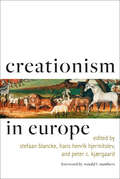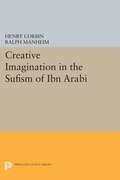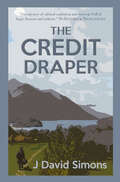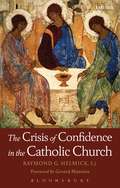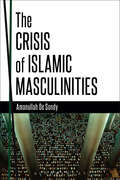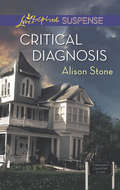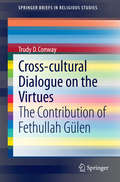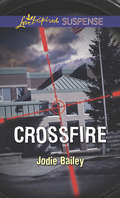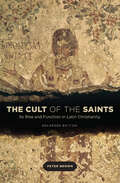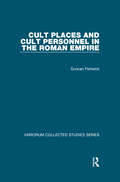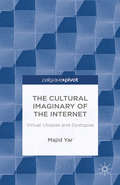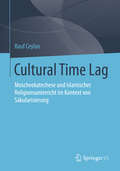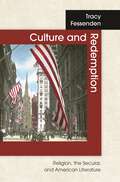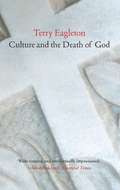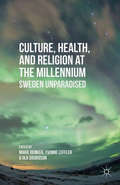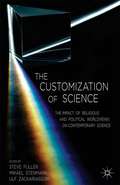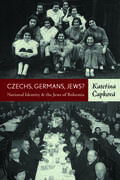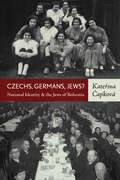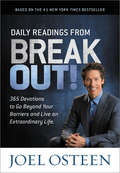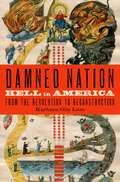- Table View
- List View
Creationism in Europe (Medicine, Science, and Religion in Historical Context)
by Stefaan Blancke Hans Henrik Hjermitslev Peter C. KjærgaardFor decades, the creationist movement was primarily situated in the United States. Then, in the 1970s, American creationists found their ideas welcomed abroad, first in Australia and New Zealand, then in Korea, India, South Africa, Brazil, and elsewhere—including Europe, where creationism plays an expanding role in public debates about science policy and school curricula. In this, the first comprehensive history of creationism in Europe, leading historians, philosophers, and scientists narrate the rise of—and response to—scientific creationism, creation science, intelligent design, and organized antievolutionism in countries and religions throughout Europe.Providing a unique map of creationism in Europe, the authors chart the surprising history of creationist activities and strategies there. Over the past forty years, creationism has spread swiftly among European Catholics, Protestants, Jews, Hindus, and Muslims, even as anti-creationists sought to smother its flames. Antievolution messages gained such widespread approval, in fact, that in 2007 the Parliamentary Assembly of the Council of Europe passed a resolution advising member states to "defend and promote scientific knowledge" and "firmly oppose the teaching of creationism as a scientific discipline on an equal footing with the theory of evolution." Creationism in Europe offers a discerning introduction to the cultural history of modern Europe, the variety of worldviews in Europe, and the interplay of science and religion in a global context. It will be of interest to students and scholars in the history and philosophy of science, religious studies, and evolutionary theory, as well as policy makers and educators concerned about the spread of creationism in our time.
Creative Imagination in the Sufism of Ibn Arabi (PDF)
by Henry Corbin Ralph ManheimA penetrating analysis of the life and doctrines of the Spanish-born Arab theologian.A penetrating analysis of the life and doctrines of the Spanish-born Arab theologian.Originally published in 1969.The Princeton Legacy Library uses the latest print-on-demand technology to again make available previously out-of-print books from the distinguished backlist of Princeton University Press. These editions preserve the original texts of these important books while presenting them in durable paperback and hardcover editions. The goal of the Princeton Legacy Library is to vastly increase access to the rich scholarly heritage found in the thousands of books published by Princeton University Press since its founding in 1905.
The Credit Draper
by J David Simons"A truly fine debut" Rodge Glass. 1911. Avram Escovitz, a young Jew, arrives in Glasgow from Russia. He dreams of playing football until WWI intervenes and he begins work as a credit draper, peddling goods to Highlanders. A stranger in a strange land, Avram must set up a new business and capture the heart of a Highland lass. But how easy will it be to shake off his Jewish roots? *New revised edition
The Crisis of Confidence in the Catholic Church (Ecclesiological Investigations)
by Raymond G. Helmick SJThe Catholic Church in the United States and Europe has seen declining numbers both in regular attendance and in clergy and religious life.Scandals have torn at people's allegiance, and feelings of disappointment, disillusion, and anger have become widespread. Church authorities have seemed reluctant to acknowledge or address these problems and have responded with vexation to those who raise them from the Right or Left. The Crisis of Confidence in the Catholic Church examines the roots of this crisis in light of the nature of the Church community, its institutional structure, and the historical experiences that have brought it to this pass. Raymond Helmick, SJ, traces the problems of the Catholic Church far back in its history - concentration of Church leadership on control of the Christian population, a requirement of obedience to their rulings rather than on the Gospel values of Jesus, the defensiveness and self-righteousness in the face of any criticism. Helmick also emphasizes the role of the Second Vatican Council as it brought the Church to an awareness of its potentiality for an active life of faith by its total membership. How will the Church revive? Helmick believes that a new growth of Christianity can come now only by a return to the love and care of its original premises, to the things that are redolent of the life of Jesus. The 'new evangelization' can only be done by living a Christian life, giving an example.
The Crisis of Confidence in the Catholic Church (Ecclesiological Investigations)
by Raymond G. Helmick SJThe Catholic Church in the United States and Europe has seen declining numbers both in regular attendance and in clergy and religious life.Scandals have torn at people's allegiance, and feelings of disappointment, disillusion, and anger have become widespread. Church authorities have seemed reluctant to acknowledge or address these problems and have responded with vexation to those who raise them from the Right or Left. The Crisis of Confidence in the Catholic Church examines the roots of this crisis in light of the nature of the Church community, its institutional structure, and the historical experiences that have brought it to this pass. Raymond Helmick, SJ, traces the problems of the Catholic Church far back in its history - concentration of Church leadership on control of the Christian population, a requirement of obedience to their rulings rather than on the Gospel values of Jesus, the defensiveness and self-righteousness in the face of any criticism. Helmick also emphasizes the role of the Second Vatican Council as it brought the Church to an awareness of its potentiality for an active life of faith by its total membership. How will the Church revive? Helmick believes that a new growth of Christianity can come now only by a return to the love and care of its original premises, to the things that are redolent of the life of Jesus. The 'new evangelization' can only be done by living a Christian life, giving an example.
The Crisis of Islamic Masculinities
by Amanullah De SondyRigid notions of masculinity are causing crisis in the global Islamic community. These are articulated from the Qur'an, its commentary, historical precedents and societal, religious and familial obligations. Some Muslims who don't agree with narrow constructs of manliness feel forced to consider themselves secular and therefore outside the religious community.In order to evaluate whether there really is only one valid, ideal Islamic masculinity, The Crisis of Islamic Masculinities explores key figures of the Qur'an and Indian-Pakistani Islamic history, and exposes the precariousness of tight constraints on Islamic manhood. By examining Qur'anic arguments and the strict social responsibilities advocated along with narrow Islamic masculinities, Amanullah De Sondy shows that God and women (to whom Muslim men relate but are different from) often act as foils for the construction of masculinity. He argues the constrainers of masculinity have used God and women to think with and to dominate through and that rigid gender roles are the product of a misguided enterprise: the highly personal relationship between humans and God does not lend itself to the organization of society, because that relationship cannot be typified and replicated. Discussions and debates surrounding Islamic masculinities are quickly finding their place in the study of Islam and Muslims, and The Crisis of Islamic Masculinities makes a vital contribution to this emerging field.
Critical Diagnosis: Shake Down Critical Diagnosis Smoky Mountain Investigation (Mills And Boon Love Inspired Suspense Ser.)
by Alison StoneHER PERSONAL PROTECTOR
Cross-cultural Dialogue on the Virtues: The Contribution of Fethullah Gülen (SpringerBriefs in Religious Studies #1)
by Trudy D. ConwayThis book explores the development of the influential worldwide Hizmet movement inspired by the Turkish scholar Fethullah Gülen, known for his moderate Islamic emphasis on peaceful relations among diverse people. It provides a detailed study of Gülen’s account of the virtues and argues that they provide the key to understanding this thinker and the movement he inspired, from its initial establishment of hospitality houses through the growth of worldwide schools, hospitals, media outlets, charitable associations and dialogue centers.The book analyzes the distinctive virtues that shaped the Hizmet movement’s ethos as well as continue to sustain its expansive energy, from the core virtues of tolerance, hospitality, compassion and charity to a host of related virtues, including wisdom, humility, mildness, patience, mercy, integrity and hope. It also examines the Islamic and Sufi roots of Gülen’s understanding of the virtues as well as presents a comparative study of Gülen’s account of the virtues in dialogue with prominent thinkers of the Western philosophical tradition and the religious traditions of Christianity, Judaism and Buddhism.The Hizmet movement provides living witness to the power and efficacy of tolerance, dialogue and peaceful relations among diverse people. This book offers an insightful portrait of the core virtues of this movement and the scholar who fully explored them within his writing. It will appeal to readers interested in virtue ethics, character education, cross-cultural studies, interfaith dialogue and the role of moderate Islam today.
Crossfire: Safe By The Marshal's Side Frame-up Race For The Gold Crossfire (Mills And Boon Love Inspired Suspense Ser.)
by Jodie BaileyA DANGEROUS REUNION
The Cult of the Saints: Its Rise and Function in Latin Christianity, Enlarged Edition
by Peter BrownIn this groundbreaking work, Peter Brown explores how the worship of saints and their corporeal remains became central to religious life in Western Europe after the fall of the Roman Empire. During this period, earthly remnants served as a heavenly connection, and their veneration is a fascinating window into the cultural mood of a region in transition. Brown challenges the long-held “two-tier” idea of religion that separated the religious practices of the sophisticated elites from those of the superstitious masses, instead arguing that the cult of the saints crossed boundaries and played a dynamic part in both the Christian faith and the larger world of late antiquity. He shows how men and women living in harsh and sometimes barbaric times relied upon the holy dead to obtain justice, forgiveness, and power, and how a single sainted hair could inspire great thinkers and great artists. An essential text by one of the foremost scholars of European history, this expanded edition includes a new preface from Brown, which presents new ideas based on subsequent scholarship.
The Cult of the Saints: Its Rise and Function in Latin Christianity, Enlarged Edition
by Peter BrownIn this groundbreaking work, Peter Brown explores how the worship of saints and their corporeal remains became central to religious life in Western Europe after the fall of the Roman Empire. During this period, earthly remnants served as a heavenly connection, and their veneration is a fascinating window into the cultural mood of a region in transition. Brown challenges the long-held “two-tier” idea of religion that separated the religious practices of the sophisticated elites from those of the superstitious masses, instead arguing that the cult of the saints crossed boundaries and played a dynamic part in both the Christian faith and the larger world of late antiquity. He shows how men and women living in harsh and sometimes barbaric times relied upon the holy dead to obtain justice, forgiveness, and power, and how a single sainted hair could inspire great thinkers and great artists. An essential text by one of the foremost scholars of European history, this expanded edition includes a new preface from Brown, which presents new ideas based on subsequent scholarship.
The Cult of the Saints: Its Rise and Function in Latin Christianity, Enlarged Edition
by Peter BrownIn this groundbreaking work, Peter Brown explores how the worship of saints and their corporeal remains became central to religious life in Western Europe after the fall of the Roman Empire. During this period, earthly remnants served as a heavenly connection, and their veneration is a fascinating window into the cultural mood of a region in transition. Brown challenges the long-held “two-tier” idea of religion that separated the religious practices of the sophisticated elites from those of the superstitious masses, instead arguing that the cult of the saints crossed boundaries and played a dynamic part in both the Christian faith and the larger world of late antiquity. He shows how men and women living in harsh and sometimes barbaric times relied upon the holy dead to obtain justice, forgiveness, and power, and how a single sainted hair could inspire great thinkers and great artists. An essential text by one of the foremost scholars of European history, this expanded edition includes a new preface from Brown, which presents new ideas based on subsequent scholarship.
The Cult of the Saints: Its Rise and Function in Latin Christianity, Enlarged Edition
by Peter BrownIn this groundbreaking work, Peter Brown explores how the worship of saints and their corporeal remains became central to religious life in Western Europe after the fall of the Roman Empire. During this period, earthly remnants served as a heavenly connection, and their veneration is a fascinating window into the cultural mood of a region in transition. Brown challenges the long-held “two-tier” idea of religion that separated the religious practices of the sophisticated elites from those of the superstitious masses, instead arguing that the cult of the saints crossed boundaries and played a dynamic part in both the Christian faith and the larger world of late antiquity. He shows how men and women living in harsh and sometimes barbaric times relied upon the holy dead to obtain justice, forgiveness, and power, and how a single sainted hair could inspire great thinkers and great artists. An essential text by one of the foremost scholars of European history, this expanded edition includes a new preface from Brown, which presents new ideas based on subsequent scholarship.
Cult Places and Cult Personnel in the Roman Empire
by Duncan FishwickThe twenty-one studies assembled in this volume focus on the apparatus and practitioners of religions in the western Roman empire, the enclaves, temples, altars and monuments that served the cults of a wide range of divinities through the medium of priests and worshippers. Discussion focuses on the analysis or reconstruction of the centres at which devotees gathered and draws on the full range of available evidence. While literary authorities remain of primary concern, these are for the most part overshadowed by other categories of evidence, in particular archaeology, epigraphy, numismatics and iconography, sources in some cases confirmed by the latest geophysical techniques - electrical resistivity tomography or ground-probing radar. The material is conveniently presented by geographical area, using modern rather than Latin terminology: Rome, Italy, Britain, Gaul, Spain, Hungary, along with a broader section that covers the empire in general. The titles of the various articles speak for themselves but readers may find the preface of interest in so far as it sets out my ideas on the use of ancient evidence and the pitfalls of some of the approaches favoured by modern scholars. Together with the wide range of individual papers the preface makes the book of interest to all students of the Roman empire as well as those specifically concerned with the history of religions.
Cult Places and Cult Personnel in the Roman Empire
by Duncan FishwickThe twenty-one studies assembled in this volume focus on the apparatus and practitioners of religions in the western Roman empire, the enclaves, temples, altars and monuments that served the cults of a wide range of divinities through the medium of priests and worshippers. Discussion focuses on the analysis or reconstruction of the centres at which devotees gathered and draws on the full range of available evidence. While literary authorities remain of primary concern, these are for the most part overshadowed by other categories of evidence, in particular archaeology, epigraphy, numismatics and iconography, sources in some cases confirmed by the latest geophysical techniques - electrical resistivity tomography or ground-probing radar. The material is conveniently presented by geographical area, using modern rather than Latin terminology: Rome, Italy, Britain, Gaul, Spain, Hungary, along with a broader section that covers the empire in general. The titles of the various articles speak for themselves but readers may find the preface of interest in so far as it sets out my ideas on the use of ancient evidence and the pitfalls of some of the approaches favoured by modern scholars. Together with the wide range of individual papers the preface makes the book of interest to all students of the Roman empire as well as those specifically concerned with the history of religions.
The Cultural Imaginary of the Internet: Virtual Utopias and Dystopias
by M. YarContemporary culture offer contradictory views of the internet and new media technologies, painting them in extremes of optimistic enthusiasm and pessimistic concern. This book explores such representations, uncovering the roots of our cultural responses to the internet, centred upon a profoundly ambivalent reaction to technological modernity.
Cultural Time Lag: Moscheekatechese und islamischer Religionsunterricht im Kontext von Säkularisierung
by Rauf CeylanMit der sukzessiven Einführung eines flächendeckenden islamischen Religionsunterrichts in Deutschland ist vor allem die Frage verbunden, wie sich in Zukunft das Verhältnis zwischen Moscheen und Schulen gestalten wird. Diese Verhältnisbestimmung ist insbesondere vor dem Hintergrund von Säkularisierung relevant, ebenso im Kontext einer historischen Analyse ähnlicher Entwicklungen von Kirchen und dem Verhältnis von Religionsunterricht in Deutschland. Denn es ist zu erwarten, dass gesellschaftliche Transformationsprozesse sich in den muslimischen Gemeinden widerspiegeln werden und es zu einer Verschiebung in der bisherigen Hierarchie der religiösen Lernorte kommen wird. Sowohl offensive als auch defensive Reaktionen im Sinne von Vereinnahmungsversuchen des schulischen Religionsunterrichts seitens der Moscheegemeinden sind möglich. Daher verfolgt die vorliegende Forschungsarbeit das Ziel, in Form von Experteninterviews die pädagogischen Herausforderungen sowie Transformationsprozesse in den Gemeinden herauszuarbeiten sowie mögliche Konflikte in der Verhältnisbestimmung der Lernorte Schule und Gemeinden zu ermitteln, um schließlich Konzepte für eine konstruktive Problemlösung für die Zukunft anzubieten.
Culture and Redemption: Religion, the Secular, and American Literature
by Tracy FessendenMany Americans wish to believe that the United States, founded in religious tolerance, has gradually and naturally established a secular public sphere that is equally tolerant of all religions--or none. Culture and Redemption suggests otherwise. Tracy Fessenden contends that the uneven separation of church and state in America, far from safeguarding an arena for democratic flourishing, has functioned instead to promote particular forms of religious possibility while containing, suppressing, or excluding others. At a moment when questions about the appropriate role of religion in public life have become trenchant as never before, Culture and Redemption radically challenges conventional depictions--celebratory or damning--of America's "secular" public sphere. Examining American legal cases, children's books, sermons, and polemics together with popular and classic works of literature from the seventeenth to the twentieth centuries, Culture and Redemption shows how the vaunted secularization of American culture proceeds not as an inevitable by-product of modernity, but instead through concerted attempts to render dominant forms of Protestant identity continuous with democratic, civil identity. Fessenden shows this process to be thoroughly implicated, moreover, in practices of often-violent exclusion that go to the making of national culture: Indian removals, forced acculturations of religious and other minorities, internal and external colonizations, and exacting constructions of sex and gender. Her new readings of Emerson, Whitman, Melville, Stowe, Twain, Gilman, Fitzgerald, and others who address themselves to these dynamics in intricate and often unexpected ways advance a major reinterpretation of American writing.
Culture and the Death of God
by Terry EagletonHow to live in a supposedly faithless world threatened by religious fundamentalism? Terry Eagleton, formidable thinker and renowned cultural critic, investigates in this thought-provoking book the contradictions, difficulties, and significance of the modern search for a replacement for God. Engaging with a phenomenally wide range of ideas, issues, and thinkers from the Enlightenment to today, Eagleton discusses the state of religion before and after 9/11, the ironies surrounding Western capitalism’s part in spawning not only secularism but also fundamentalism, and the unsatisfactory surrogates for the Almighty invented in the post-Enlightenment era. The author reflects on the unique capacities of religion, the possibilities of culture and art as modern paths to salvation, the so-called war on terror’s impact on atheism, and a host of other topics of concern to those who envision a future in which just and compassionate communities thrive. Lucid, stylish, and entertaining in his usual manner, Eagleton presents a brilliant survey of modern thought that also serves as a timely, urgently needed intervention into our perilous political present.
Culture, Health, and Religion at the Millennium: Sweden Unparadised
by Ola Sigurdson Marie Demker Yvonne LefflerThe book presents interpretations of culture, health, politics, and religion in Sweden today, Sweden transforms from the well-functioning but existentially bland economic wonder to a more fragmented and gloomy society. Contributors include scholars from film studies, literary studies, political science, religious studies and theology
The Customization of Science: The Impact of Religious and Political Worldviews on Contemporary Science
by Steve Fuller Mikael Stenmark Ulf ZackariassonThis collection explores whether and how religious and secular worldviews and political ideologies held by scientists, citizens, decision-makers and politicians influence science as practiced and understood today. Contributors explore the social and scientific repercussions of 'customizing' science to fit the needs and interests of various groups.
Czechs, Germans, Jews?: National Identity and the Jews of Bohemia
by Kateřina ČapkováThe phenomenon of national identities, always a key issue in the modern history of Bohemian Jewry, was particularly complex because of the marginal differences that existed between the available choices. Considerable overlap was evident in the programs of the various national movements and it was possible to change one’s national identity or even to opt for more than one such identity without necessarily experiencing any far-reaching consequences in everyday life. Based on many hitherto unknown archival sources from the Czech Republic, Israel and Austria, the author’s research reveals the inner dynamic of each of the national movements and maps out the three most important constructions of national identity within Bohemian Jewry – the German-Jewish, the Czech-Jewish and the Zionist. This book provides a needed framework for understanding the rich history of German- and Czech-Jewish politics and culture in Bohemia and is a notable contribution to the historiography of Bohemian, Czechoslovak and central European Jewry.
Czechs, Germans, Jews?: National Identity and the Jews of Bohemia
by Kateřina ČapkováThe phenomenon of national identities, always a key issue in the modern history of Bohemian Jewry, was particularly complex because of the marginal differences that existed between the available choices. Considerable overlap was evident in the programs of the various national movements and it was possible to change one’s national identity or even to opt for more than one such identity without necessarily experiencing any far-reaching consequences in everyday life. Based on many hitherto unknown archival sources from the Czech Republic, Israel and Austria, the author’s research reveals the inner dynamic of each of the national movements and maps out the three most important constructions of national identity within Bohemian Jewry – the German-Jewish, the Czech-Jewish and the Zionist. This book provides a needed framework for understanding the rich history of German- and Czech-Jewish politics and culture in Bohemia and is a notable contribution to the historiography of Bohemian, Czechoslovak and central European Jewry.
Daily Readings from Break Out!: 365 Devotions to Go Beyond Your Barriers and Live an Extraordinary Life
by Joel OsteenFind uplifting quotes, thought-provoking prayers, and life-changing inspiration with this daily reading companion to Break Out! from Lakewood Church pastor Joel Osteen.We were not created to just get by with average, unrewarding or unfulfilling lives. God created us to leave our marks on our generations. Every person has seeds of greatness planted within by the Creator. This devotional will help readers break out and break free so they can believe bigger, increase their productivity, improve their relationships, and accomplish their dreams. Filled with faith and motivation, Daily Readings from Break Out! challenges readers to have a new perspective, to let nothing hold them back, and to reject any labels that might limit them.
Damned Nation: Hell in America from the Revolution to Reconstruction
by Kathryn Gin LumAmong the pressing concerns of Americans in the first century of nationhood were day-to-day survival, political harmony, exploration of the continent, foreign policy, and--fixed deeply in the collective consciousness--hell and eternal damnation. The fear of fire and brimstone and the worm that never dies exerted a profound and lasting influence on Americans' ideas about themselves, their neighbors, and the rest of the world. Kathryn Gin Lum poses a number of vital questions: Why did the fear of hell survive Enlightenment critiques in America, after largely subsiding in Europe and elsewhere? What were the consequences for early and antebellum Americans of living with the fear of seeing themselves and many people they knew eternally damned? How did they live under the weighty obligation to save as many souls as possible? What about those who rejected this sense of obligation and fear? Gin Lum shows that beneath early Americans' vaunted millennial optimism lurked a pervasive anxiety: that rather than being favored by God, they and their nation might be the object of divine wrath. As time-honored social hierarchies crumbled before revival fire, economic unease, and political chaos, "saved" and "damned" became as crucial distinctions as race, class, and gender. The threat of damnation became an impetus for or deterrent from all kinds of behaviors, from reading novels to owning slaves. Gin Lum tracks the idea of hell from the Revolution to Reconstruction. She considers the ideas of theological leaders like Jonathan Edwards and Charles Finney, as well as those of ordinary women and men. She discusses the views of Native Americans, Americans of European and African descent, residents of Northern insane asylums and Southern plantations, New England's clergy and missionaries overseas, and even proponents of Swedenborgianism and annihilationism. Damned Nation offers a captivating account of an idea that played a transformative role in America's intellectual and cultural history.
